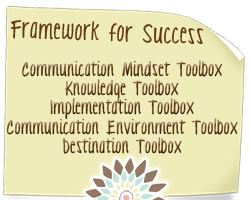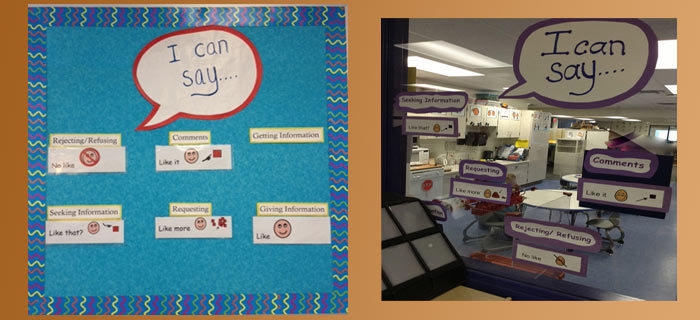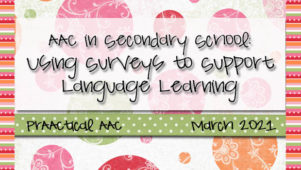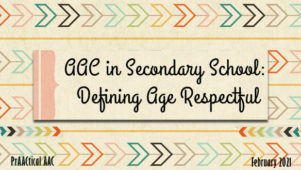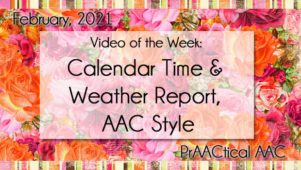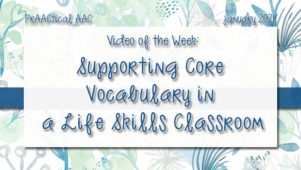How I Do It: A Framework for Success-Getting Started in the Exciting World of Communication and AAC
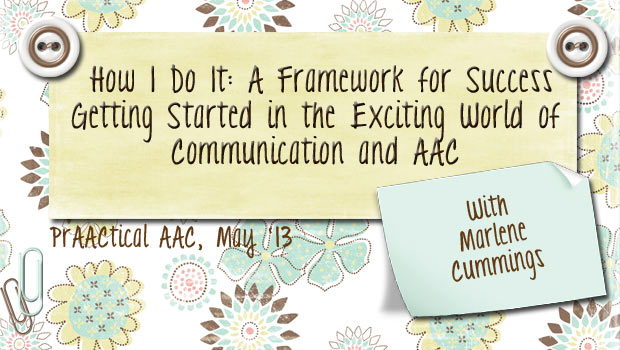
We couldn’t be more excited to have a return visit from Marlene Cummings, a wonderful SLP who is currently serving as an AAC Consultant to the AAC Team at Oakland Schools. In her first post, Marlene talked about strategies for cultivating the right mindset for AAC teaching. In this post, Marlene continues sharing elements of her Framework for Success in discussing the Knowledge Toolbox, developed with the Oakland Schools AAC Team.
5 Things in Your “Knowledge Toolbox”
What is already in my “knowledge toolbox” of communication, language and learning? Yes, you do have a full toolbox. You just don’t realize it. And of course there are always new and exciting things to add.
You already know this stuff!! REMEMBER???
It is important to step back and think broadly about communication and what it really does. Sometimes we get caught in the details of our work and can’t see the forest through the trees.
1. Typical language development: What do we already know and how do we connect that knowledge when considering AAC? We know “Language Development” inside and out; we just forget to apply this knowledge to our students with complex communication needs. Joan Bruno and Gail Vantatenhove, just to name a few, have given us wonderful resources to remind us. “Normal Language Development, Generative Language & AAC by Gail Vantatenhove” is a great place to start.
With our background knowledge we can begin to consider what vocabulary would be needed to participate in the purposes of communication. We will explore more about vocabulary and ways we use it to communicate.
“The limits of my language are the limits of my world.” (Ludwig Wittenstein)
2. Purposes of communication: We sometimes need to remind ourselves why we communicate.
Purposes of Communication:
- Express wants and needs
- Gain and share information
- Build and sustain relationships
- Engage in social etiquette
The first time I was introduced to these I was sure there had to be more. All communication could not fit into one of these categories. Yet it does. We often see teams experiencing “ahha” moments as they consider these purposes. Some reflections:
- “This makes perfect sense. I can provide communicative opportunities with these in mind.”
- “Our team puts these purposes right into our lesson plans so that every week we make sure we address them.”
- “Thanks for sharing this. It has showed us that even though we support the students through our own lens (social work, speech/language, teacher) we each have an important role to play in modeling and providing communication opportunities each time we work with the our students.”
Interaction Involving individuals using AAC systems: State of the art and future directions,
Augmentative and Alternative Communication, 1988, Vol.4, No. 2: Pages 66-82
Janice Light, 1988
3. Functions of communication: We also need to remember how we communicate.
Functions of communication; a few to consider:
- Calling attention
- Denying or protesting
- Requesting object, action or event
- Initiating communication with a question or comment
- Directing action of another person
- Social comments, exclamations in appropriate contexts
- Calling attention to self-achievement
- Combining thoughts into longer utterances to expand an idea
- Using words to describe location
- Asking simple questions
From: Total Augmentative Communication in the Early Childhood Classroom
Linda Burkhart, 1993
In one discussion about the “functions” we were discussing when we might see at least the beginning use of most of the functions. We started at “maybe 5 or 6 years old,” then well, “maybe 4 or 5”…slowly we kept getting younger and younger until one of our AAC consultants commented that her 2 and ½ year old “speech impaired” son was demonstrating almost all of them. It stopped all of us in our tracks for a moment. What were our expectations for our emergent communicators? Is there something beyond requesting?
Eighteen months ago we, at Oakland Schools, implemented several new strategies. One of those strategies was the formal implementation of a “core vocabulary” approach to learning language and augmenting expressive communication. We considered the research, reviewed many of the present vocabulary sets in the field and with years of professional experience amongst us chose 32 initial core words. Rather than try to hit perfection, we decided to “just get started” We are so glad we did. We continue to review and revise our “core” words, mostly through feedback from our teams. We would not have their knowledge to draw from if we were still in the planning stage. More will be shared about “core vocabulary” and some exciting work being done by the Center for Literacy and Disability Studies.
Now back to the functions of communication. One of our favorite activities is to see how many 2, 3 and 4 word phrases we can generate using just those 32 core words and how many functions of communication are represented. One of my teams serving students birth-5 came up with 189 different phrases. Then another team decided to see how many functions were represented in those 189 phrases. They were able to sort the phrases into functions such as requesting, protesting, rejecting, and commenting. One team said, “We found the activity energizing”. “We feel like we can get started tomorrow using the core vocabulary”. That’s the feeling we had hoped for. We knew all along they could do it…now they believe it too.
At first the teams were a bit challenged, then it became easier and easier to keep the “functions” on their radar. One of our teams accomplished this by making a bulletin board.
The idea caught on. Two teams decided to use this as a way to share with all their staff which phrases they were targeting each week keeping everyone on the same page. They could then purposefully model and provide opportunity for students to use these phrases multiple times a day. Each week more phrases would be added. The phrases on the right are removable so they can be used as an instructional and modeling tool.
4. Communicative Competence: Here are two ways of looking at communicative competence that we share with our teams.
Janice Light took an already established approach to language learning “communicative competence” and applied it to AAC with incredible results. Assessments and frameworks alike have been designed from her work. She states that the development of communicative competence requires the acquisition and integrations of skills in four areas: Linguistic, Social, Strategic and Operational
Light, J. (1989), “Toward a definition of communicative competence for individuals using augmentative and alternative communication systems.” Augmentative and Alternative Communications 5 (2): 137-144
Pat Dowden shares another important way to view communication and AAC. She looks at communication through the lens of the communicator who is Emerging, Context-Dependent or Independent.
Dowden, P.A. (1999). Augmentative & Alternative Communication for Children with Motor Speech Disorders. In Caruso, A., and Strand, E. A. Eds.) Clinical Management of Motor Speech Disorders of Children. New York: Thieme Publishing Co.
We sometimes use a “sticky note” activity to share our thoughts on “communicative competence”. We asked several members of our AAC Professional Learning Community to put on sticky notes what they thought a “competent communicator” would look like. They said, “Communicate their wants and needs”, “functional communication”, “share what they don’t like”, to name a few. On the other side folks shared that they wanted students to communicate in more complex and complete sentences. We realized that many of us underestimate the full breadth of communication we should be expecting our students to be able to use or we forget how typical language develops and what that looks like communicatively.
5. Learning language and learning to communicate: We need to consider that in the first 7-9 years a typical communicator is learning language and learning how to use that language to communicate and to learn. One thing we often forget is to consider the “language level” of the student we are augmenting, not their age or amount of vocabulary in their AAC Systems. We have to put our “language” hat back on. We would not expect an emergent communicator to request something by requiring them to say: “I want to go to McDonald’s and get a girl’s fun meal with a toy”. We would easily understand and accept: (“Me go Donald’s get toy”).
Remember the activity where the teams generated all those “core vocabulary” phrases, categorized them in “functions” and displayed them on their wall? They discovered some exciting things:
- They began modeling a variety of ways to request rather than just “I want”.
- Want it
- Get more that
- You play me
- Make it again
- Students were participating in multiple communicative opportunities within a function, thus beginning to grasp the power of requesting using a variety of words.
- This same result was seen across multiple functions.
I recently heard Dr. Karen Erickson and Dr. David Koppenhaver speaking about literacy. They made a statement that caused me to pause and think about AAC and communication. Their statement, as I remember it was “doing hard things does not mean we will learn or move forward. Take “challenge” out and replace it with “engagement” for as many minutes a day as we possibly can”.
How many opportunities do we give our students at their communication/language level? Are we at risk of expecting them to use the complex language available on their systems just because it’s there and sounds better to our adult ears? Remember, we design the vocabulary sets on the AAC systems so the students can grow into them and to additionally augment their receptive language.
Marlene has more to share on her Framework for Success. Look for later posts on implementation, the communication environment, and the destination.
Filed under: PrAACtical Thinking
Tagged With: AAC team, classroom, communication opportunities, communicative competence, communicative function, communicative intent, education, How I Do It, language development, Marlene Cummings, schools
This post was written by Carole Zangari
